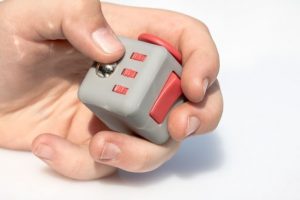General Information
“Why is it That My Child Can’t Sit Still?” – Here’s How to Help
My child can’t sit still, this a question often asked: Are our children more fidgety and less focused than ever? According to the most recent statistics, 11% of all children are officially diagnosed with Attention Deficit Hyperactivity Disorder (ADHD).
There are certainly more and more children receiving the diagnosis than ever. But that might just be attributed to a greater awareness and enlightening research of the physiological components that comprise ADHD.
Specifically, ADHD is characterized by 3 predominant symptoms:
1. Hyperactivity
2. Distractability
3. Impulsivity
For parents and teachers of children with ADHD, these symptoms are a daily battle with progress. It’s impossible to get through a lesson at school, or homework in the evenings, if your child can’t sit still.

“Why can’t my child sit still?!”
Does it seem to you that children today don’t have the patience and self-control of generations before? If you’ve become caught up in TV’s remake of Anne of Green Gables like I have, you might be surprised by the stark contrast of schoolchildren portrayed in 1918 sitting quietly in rows of desks.
No fidget spinners, no animated video lessons, no movement breaks. Just hours of sitting still, broken only by going to the chalkboard to answer a question.
Haven’t things changed drastically in 100 years?
The “traditional” desk arrangement is almost a thing of the past. Nowadays, research proves overwhelmingly in favour of clustered seating, round tables, floor seating and work stations. And, even “fidget-friendly” seating options.
“Is it normal that my child can’t sit still?”
If your child can’t sit still through a storybook reading or seems especially wiggly and fidgety to you, don’t worry. It doesn’t automatically mean he or she has an attention deficit.
It seems to me that there are several practical, cultural reasons why today’s child can’t sit still.
1. We’ve changed the definition of “normal.”
In fact, Dr David Elkind, human development specialist and author of The Hurried Child, says society has reduced what “normal” looks like in a child. What was once referred to as an energetic or enthusiastic child is now quickly labelled with ADHD.
It’s obviously important to talk over concerns about your child’s behaviour with a pediatrician or specialist. This is because ADHD is a clinical disorder with real physiological components. However, a fidgety child doesn’t necessarily have all of the physiological deficits or symptoms of ADHD.
2. Modern society is fast-paced.
Thanks to picture-in-picture TV, scrolling news bars, and cell phone message alerts, our brains are constantly in multitask mode. The last two decades have ushered in an expectation to accomplish the work of two people at our jobs.
The problem is that all of this multitasking eats away at our overall ability to concentrate on one thing when we need to. Our children are being raised amongst over-stimulation, and it’s a vicious cycle.
3. More screens = less focus.
Screens and the blue light they emit affect our children’s ability to focus. Find out more about how screens negatively affect the brain chemistry of children. Our recent article: Limiting Children’s Screen Time – How Screen Time Affects a Child’s Brain and Sensory Processing Abilities is essential reading for all parents, carers and teachers.
4. Not enough physical movement & variety.
Many children simply aren’t getting enough physical movement to expend the energy their bodies produce. According to most pediatricians and health experts, children ages 6-17 should partake in at least 1 hour or more of physical activity every day.
Most schools include 30 minutes of recess to allow for exercise, but the reality is that not all children spend their recess exerting energy. There aren’t always state or nationwide standards for the required amount of physical education (PE), and most primary schools seem to only offer one hour per week.
With childhood obesity at an all-time high, it’s obvious that on average, our children are not getting enough physical activity.
5. High caffeine, high sugar diet.
Speaking of energy production, when children consume more caffeine and/or sugar than their body is naturally equipped to process, the result is excess energy.
Regardless of whether your child has ADHD or is simply an energetic kid, there are ways you can help. Here are the strategies I suggest you try at home or at school to help him or her be less fidgety. Or if not less fidgety, at least to channel their energy into a productive lifestyle.
If a Child Can’t Sit Still – Here’s How to Help
1. Include exercise in a daily routine.
Exercise is the simplest, most broad solution to 3 out of the 5 reasons a child can’t sit still. Exercise is the best way to combat boredom and a sedentary lifestyle habit. Plus, there is plenty of research that shows that extra, routine physical activity reduces ADHD-related behaviours.
Finding a way to include 20-30 minutes of movement into your morning routine will help your child’s body and mind get aligned for the day.
Take a realistic survey of how much time each day your child raises his/her heart rate.
The types of movements can make a big difference too. Specific vestibular and proprioception movements are types of movement that address any gaps in the awareness of the body in space that might be due to dyspraxia, SPD, ASD or a number of other developmental disabilities.
However, all children benefit from these types of developmental activities. Coordination, balance, self-regulation of emotions and focus on tasks can all be strengthened with the practice of vestibular stimulation & proprioceptive activities.
For this reason, our program of in-home exercises incorporates these types of specific movements. The CoordiKids Home course series is a great way to incorporate proper movement in your child’s routine. They’re sent straight to your inbox every other week, and 15 minutes a day is all you need to complete them and strengthen your child’s focus and self-regulation.
2. Monitor your family’s diet.
Eating healthy contributes significantly to our ability to focus and sit still. Sugar and caffeine are typically the two biggest offenders when it comes to throwing your child’s energy and focus off-balance. Typical recommendations for daily sugar intake for children range from 12-25 grams per day.
That’s about 3-6 teaspoons. (Of course, this number can vary depending on your child’s age, weight, and caloric needs.) Set firm rules about how many treats per day/week your child can have. You could even instil a rule that allows your child to earn treats by completing certain amounts of physical activity.
To help you with your rule-setting, here are a few examples of what comprises a maximum daily serving of sugar:
- Half of a regular-sized Hershey chocolate bar
- 1.5-2 fun sized candy bars
- Less than one fun-size Skittles (fun size = 30g!)
- 5-6 small lollies
- 2-3 sweet biscuits
- 1 slice of cake
- 1 small muffin
- 2 scoops of ice cream
- 1 tablespoon of syrup/honey
Also, make sure your child gets a full portion of protein at every meal. Protein can prevent surges in blood sugar, which increase hyperactivity.
Plus, and it’s no great surprise to me, new research links junk food and ADHD-related behaviours. So, it’s critical to keep junk food from being a dietary staple.
3. Learn to meditate together.
Studies have shown again and again how effective the act of meditation is on improving the attention span of adults. Comparisons are showing us that it is equally as effective with adults with ADD/ADHD versus those without.
Now, the focus is turning to how well it works to improve concentration for kids, too.
In 2004 we heard that children with ADHD who meditated with their parents twice each week in therapy sessions had better focus in school. Another study showed that it took as little as 8 weeks of practicing for an overall trend in improved concentration and fewer hyperactive behaviours in boys with ADHD.
Specifically, a meditation method called the Sahaja Yoga Meditation has been shown to work very well helping children and their parents together.
Even better? Other benefits cited by the families in these studies include:
- Better sleep
- Less anxiety
- An overall feeling of being more happy
- Parents’ suggesting a feeling of being able to manage their children’s behaviour better.
I’m sure there’s not a parent in the world that wouldn’t welcome any of those four benefits in their life.
4. Talk to your school about movement breaks.
5 minutes of movement between lessons can make a huge impact in your student’s attention and behaviour in the classroom. Research shows that movement breaks make learning more efficient.
Movement breaks also allow students a chance to regulate or interrupt any anxiety, stress, or sensory overwhelm. Physical activity also increases oxygen to the brain, which is critical for attention and learning.
In fact, did you know that there are certain proven physical exercises to improve concentration for school children? Research in occupational therapy and other disciplines has led to several programs of this kind that show teachers specific sets of exercises to improve concentration in the classroom. These programs are perfect for movement breaks.
For example, CoordiKids home course series is a series of exercises designed by pediatric occupational therapists specifically to increase a student’s attention span in the classroom. The program is designed for teachers to utilize as movement breaks in the classroom.
The best part for teachers is that they can simply push play on the video without any additional prep or assistance. There are enough videos in the program to use a new one every week for the whole school year – or mix them up each day.
5. Experiment with focused fidget activities.
Even though you’re worried that your child can’t sit still, research has shown that fidgeting with toys improve focus and attention, as well as aid in self-regulation.
For children with ADHD, studies have shown a 10% increase in test scores for children who were allowed a fidget toy during the test.

In addition to commercially-available fidget tool such as spinners and clickers, there are plenty of DIY fidget tools you could try with your children. Some teachers are including them in the regular school supplies lists, too! Take some time to talk to your child’s teacher about how to experiment with fidget tools, without disrupting the rest of the students in class.
6. Make sure your child gets enough sleep.
If your child isn’t getting at least 8-9 hours of sleep each night, his brain and body won’t be able to stay focused or relaxed. Put a ban on sugar and caffeine at least 2 hours before bedtime. Also, it’s important to put an end to screen time at least an hour before bed, to ensure a restful night.
Don’t hesitate to seek help
If you feel overwhelmed by your child’s inability to sit still, don’t be on your own. Ideally, you should consider setting up a consultation with a child development specialist.
Perhaps there is more to your child’s focus problems that could be helped by a professional’s advice. Feel free to set up a consultation with our team of pediatric development experts, or see your pediatrician.
Whatever the situation, there are plenty of resources, exercises, and programs available that are simple and fun. So, you can do them with your children at any time, to help them cope. This is why we set up our series of at-home therapeutic motor skills activities called CoordiKids home course series.